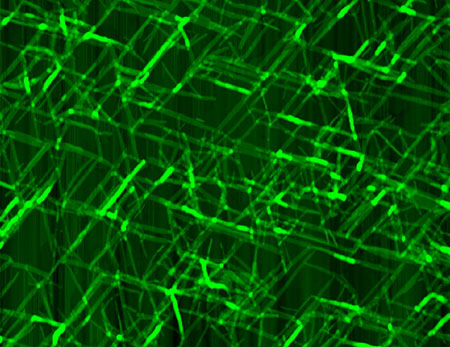| Posted: Jul 29, 2016 |
Materials scientists make breakthrough in biomimetic coatings
(Nanowerk News) Nature exquisitely assembles proteins and peptides into highly ordered functional materials, such as those critical for bone formation. These natural materials inspire researchers to innovate approaches to mimic nature for a range of potential biomedical applications. Recently Pacific Northwest National Laboratory (PNNL) -led materials scientists assembled networks of highly ordered synthetic protein-like polymers (peptoids) on a flat surface, marking a major breakthrough in biomimetic coatings (ACS Nano, "Surface-Directed Assembly of Sequence-Defined Synthetic Polymers into Networks of Hexagonally Patterned Nanoribbons with Controlled Functionalities").
|
|
That research team, led by PNNL's Chun-Long Chen, successfully achieved self-assembly of peptoids into networks of hexagonally patterned nanoribbons on a mineral surfaces. What does that mean to someone who isn't a materials scientist? It means the researchers coated protein-like molecules on solid surfaces in a highly ordered way to create materials similar to hard tissue surfaces, like bones or sea shells. This is similar to how naturally occurring proteins form organized arrays to endow tissues with unique properties. The researchers' novel approach could potentially lead to the development of biomimetic coating materials for a variety of applications.
|
 |
| This microscopy image shows the two-dimensional network of hexagonally-patterned nanoribbons formed by the self-assembly of synthetic protein-like polymers (peptoids) on a mineral surface.
|
|
Why It Matters
|
|
Proteins found in Nature form the molecular machines that make life possible. Peptoids are highly stable, protein-like molecules developed by scientists to mimic natural proteins. They are cheap, versatile, and customizable and can be designed to have specific forms and functions. Molecular self-assembly is key in biology to building well-defined protein materials. The researchers were able to achieve a controllable self-assembly of peptoids on a flat surface by manipulating molecular-level interactions through advanced chemistry and microscopy techniques.
|
|
Their breakthrough provides a new and robust platform from which to assemble sequence-defined synthetic polymers into biomimetic materials. Resulting applications from the science could include surface coatings with tunable functions for use in bone repair or regeneration, cell adhesion, antifouling, antibacterial activities, and more.
|
|
Methods
|
|
Chen's research team achieved the controllable assembly of sequence-defined peptoids by manipulating their side-chain chemistry to tune molecular interactions. They then used a special microscope that can see molecules to observe the peptoid assembly in real-time. Researchers also measured how much energy it took to pull the peptoids away from each other and from the mineral surface. The combined results enabled the team to better understand the mechanisms that lead to assembly of these peptoids into hexagonally patterned nanoribbons. They further demonstrated that surface-directed peptoid assembly can be used as a tool to fabricate biomimetic coating materials with controlled functionalities.
|
|
What's Next?
|
|
The team is pushing peptoids to do more through PNNL's Materials Synthesis and Simulation Across Scales Initiative and the U.S. Department of Energy's Office of Basic Energy Sciences' Biomolecular Materials Program. They are studying the ability of peptoids to self-assemble both on solid surfaces and in solution to develop new materials, such as biomimetic membranes. Ultimately, they hope to achieve a more complete understanding of peptoid assembly that is programmable and predictable.
|

